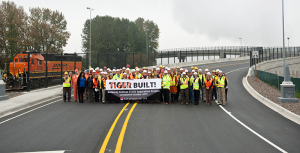TIGER II grant funds help complete new overpass
 VANCOUVER, Wash. – The Port of Vancouver USA announced today the completion of the Gateway Avenue Grade Separation project, a vital transportation link that allows safer and more efficient movement of cargo and improved access to marine terminals for port tenants and customers.
VANCOUVER, Wash. – The Port of Vancouver USA announced today the completion of the Gateway Avenue Grade Separation project, a vital transportation link that allows safer and more efficient movement of cargo and improved access to marine terminals for port tenants and customers.
Officially opened to traffic on October 18, the $15.9 million project realigned Gateway Avenue and built a 3,100 foot bridge over the port’s expanding rail corridor. By separating vehicular traffic from the rail traffic below, the project reduces delays and makes it easier for trucks and other vehicles to enter and exit port terminals.
“The new overpass is great,” said Tony Carnera, manager of the Northwest Division of CalPortland Sand and Gravel, a port tenant since 1992. “Our trucks now have direct, unimpeded access to Terminal 4, which not only makes it safer for our drivers, but the reduced travel times are good for business.”
The grade separation project, part of the port’s $275 million West Vancouver Freight Access (WVFA) project, crosses over two existing rail lines and is designed to accommodate significant future rail expansion. Prior to the project’s completion, both trains and vehicles accessed Terminals 4 and 5 by crossing an at-grade intersection on Gateway Avenue. As trains traveled over Gateway Avenue, vehicles using the roadway were often delayed, sometimes waiting up to 15 minutes to cross the railroad tracks.
Total cost for the project, including engineering, design, permitting and construction, was approximately $17.3 million, with the project coming in on budget. Funding for the project was provided in part by a $10 million federal Transportation Investment Generating Economic Recovery (TIGER) II grant secured by the port in April 2011. Approximately $8.8 million of the TIGER II funds were used to construct the Gateway overpass. The remaining grant funds were used for other rail infrastructure improvements.
The TIGER program was originally created in 2009 by our own U.S. Senator Patty Murray as part of the American Recovery and Reinvestment Act, and she has been a strong advocate since in her role as the chairman of the Senate Transportation and Housing Appropriations Subcommittee. Senator Murray, along with U.S. Senator Maria Cantwell and Rep. Jaime Herrera Beutler, was a strong supporter of the port’s TIGER II application, as well as several additional federal grants the port has received for the WVFA in the past.
“This is an excellent example of how investing in transportation infrastructure results in economic benefit,” said Todd Coleman, CEO for the port. “Thanks to the TIGER II funding and the ongoing support of our federal delegation, this project created 174 direct jobs related to construction and moves us closer to completing our WVFA project, which we expect will create thousands of permanent jobs in our community.”
Washington contractor Apollo, Inc., headquartered in Kennewick, began construction on the project in December 2011, with an anticipated completion date of March 2013. However, because soils surrounding the bridge remained unusually wet throughout the spring and summer of this year, final work on the project was delayed until August. The decision to wait until the soil settled properly is expected to reduce future maintenance costs.
Completion of the entire WVFA project is anticipated in 2017 and is expected to attract more than $500 million in private-sector investment and create between 1,000 and 2,000 new, permanent jobs. In addition, 4, 000 construction jobs are projected to be generated over the life of the project.
